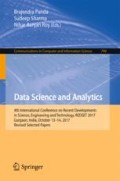Abstract
Machine learning is being used in every field. In almost all technical and financial domains, machine learning is being used enormously from predicting new outcomes to classifying a given data into multiple sets. In this research work it has been tried to build and expand upon previously built binary classifiers to develop a unique classifier for skin detection that separates the given input data into two sets – Skin segment and Non-Skin segment. Skin Detection essentially means detecting in an image or video pixels or regions which are of the skin color. The input data given to the classifier has three attributes - value of the red, green and blue channel. The combination of these three values is the color of the object seen. The classifier classifies the input data into the above two classes on the basis of these attributes. In general, this classifier can be extended to any binary class data.
Access this chapter
Tax calculation will be finalised at checkout
Purchases are for personal use only
References
Alpaydin, E.: Introduction to Machine Learning (2010). [Sl]
Elgammal, A., Muang, C., Hu, D.: Skin detection-a short tutorial. Encycl. Biom., 1–10 (2009)
Alala, B., Mwangi, W., Okeyo, G.: Image representation using RGB color space. Int. J. Innov. Res. Dev. 3(8) (2014)
Keller, J.M., Gray, M.R., Givens, J.A.: A fuzzy k-nearest neighbor algorithm.IEEE Trans. Syst. Man Cybern. (4), 580–585 (1985)
Van Laarhoven, P.J., Aarts, E.H.: Simulated annealing. In: Simulated annealing:Theory and applications, pp. 7–15. Springer, Netherlands (1987)
Bhatt, R., Dhall, A.: Skin segmentation dataset. UCI Machine LearningRepository (2010)
Vezhnevets, V., Sazonov, V., Andreeva, A.: A survey on pixel-basedskin color detection techniques. In: Proceedings of the Graphicon, vol. 3, pp. 85–92, September 2003
Jones, M.J., Rehg, J.M.: Statistical color models with application to skin detection. Int. J. Comput. Vis. 46(1), 81–96 (2002)
Kakumanu, P., Makrogiannis, S., Bourbakis, N.: A survey of skin-colormodeling and detection methods. Pattern Recognit. 40(3), 1106–1122 (2007)
Brand, J., Mason, J.S.: A comparative assessment of three approaches topixel-level human skin-detection. In: Proceedings of the 15th International Conference on Pattern Recognition, vol. 1, pp. 1056–1059. IEEE (2000)
Jedynak, B., Zheng, H., Daoudi, M.: Maximum entropy models for skin detection. In: International Workshop on Energy Minimization Methods in Computer Vision and Pattern Recognition, pp. 180–193. Springer, Heidelberg, July 2003
Brown, D. A., Craw, I., Lewthwaite, J.: A SOM based approach to skin detection with application in real time systems. In: BMVC, vol. 1, pp. 491–500, July 2001
Lee, J.Y., Yoo, S.I.: An elliptical boundary model for skin color detection. In: Proceedings of the 2002 International Conference on Imaging Science, Systems, and Technology, June 2002
Joenes, M., Rehg, J.: Statistical color models with application to skin detection. In: IEEE Conference Computer Vision and Pattern Recognition. In: CVPR, vol. 99, pp. 274–280 (1999)
Sebe, N., Cohen, I., Huang, T.S., Gevers, T.: Skin detection: a Bayesian network approach. In: Proceedings of the 17th International Conference on Pattern Recognition, ICPR 2004, vol. 2, pp. 903–906. IEEE, August 2004
Setnes, M., Roubos, H.: GA-fuzzy modeling and classification: complexity and performance. IEEE Trans. Fuzzy Syst. 8(5), 509–522 (2000)
Saha, P., Mandal, R.: Detection of Dengue Disease Using Artificial Neural Networks (2017)
Imandoust, S.B., Bolandraftar, M.: Application of k-nearest neighbor (knn) approach for predicting economic events: Theoretical background. Int. J. Eng. Res. Appl. 3(5), 605–610 (2013)
Goffe, W.L., Ferrier, G.D., Rogers, J.: Global optimization of statistical functions with simulated annealing. J. Econom. 60(1-2), 65–99 (1994)
Liensberger, C., Stöttinger, J., Kampel, M.: Color-based skin detection and its application in video annotation
Author information
Authors and Affiliations
Corresponding author
Editor information
Editors and Affiliations
Rights and permissions
Copyright information
© 2018 Springer Nature Singapore Pte Ltd.
About this paper
Cite this paper
Aggarwal, S., Bhandari, L., Kapoor, K., Kaur, J. (2018). Weighted Fuzzy KNN Optimized by Simulated Annealing for Classification of Large Data: A New Approach to Skin Detection. In: Panda, B., Sharma, S., Roy, N. (eds) Data Science and Analytics. REDSET 2017. Communications in Computer and Information Science, vol 799. Springer, Singapore. https://doi.org/10.1007/978-981-10-8527-7_14
Download citation
DOI: https://doi.org/10.1007/978-981-10-8527-7_14
Published:
Publisher Name: Springer, Singapore
Print ISBN: 978-981-10-8526-0
Online ISBN: 978-981-10-8527-7
eBook Packages: Computer ScienceComputer Science (R0)

